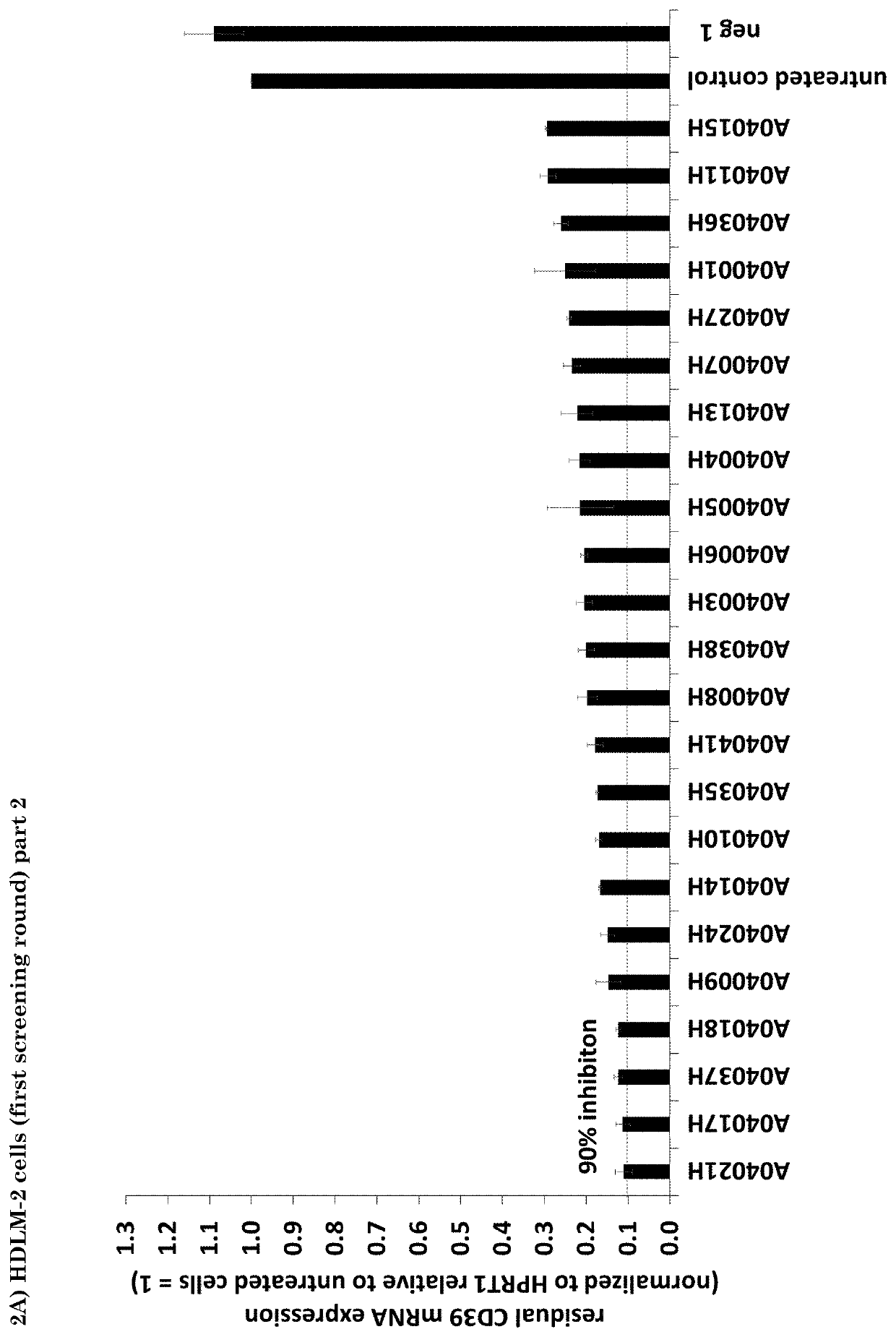Immunosuppression-Reverting Oligonucleotides Inhibiting the Expression of CD39
a technology of immunosuppression and reverse oligonucleotide, which is applied in the direction of cardiovascular disorders, immunological disorders, drug compositions, etc., can solve the problems of high dose and high frequency of small molecules, antibody and/or small molecules cannot be used in the same way or hardly suitable approaches
- Summary
- Abstract
- Description
- Claims
- Application Information
AI Technical Summary
Benefits of technology
Problems solved by technology
Method used
Image
Examples
example 1
Human CD39 Antisense Oligonucleotides
[0059]For the design of antisense oligonucleotides with specificity for human (h) CD39 the hCD39 mRNA sequence with SEQ ID No. 1 (seq. ref. ID NM_001776.5) was used. 14, 15, 16 and 17 mers were designed according to in-house criteria, neg1 (described in WO2014154843 A1) was used as control antisense oligonucleotide in all experiments (Table 1). The distribution of the antisense oligonucleotide binding site on the hCD39 mRNA is shown in FIG. 1.
example 2
Screen of hCD39 Antisense Oligonucleotides in Human Cancer Cell Lines
[0060]In order to analyze the efficacy of hCD39 antisense oligonucleotides of the present invention with regard to the knockdown of hCD39 mRNA expression in cancer cell lines, HDLM-2 (human Hodgkin Lymphoma, DSMZ) and A-172 (human glioblastoma, ATCC) cells were treated with a single dose (concentration: 10 μM without addition of any transfection reagent; this process is called gymnotic delivery) of the respective antisense oligonucleotide as shown in FIG. 2A to 2D. hCD39 and HPRT1 mRNA expression was analyzed three days later using the QuantiGene Singleplex assay (Affymetrix) and hCD39 expression values were normalized to HPRT1 values. Strikingly, a knockdown efficiency of >90% was observed for 23 and 18 (HDLM-2 cells; see FIGS. 2A and 2B) and of >90% was observed for 8 and 10 (A-172 cells) antisense oligonucleotides (see FIGS. 2C and 2D). Values of the mean normalized mRNA expression of hCD39 compared to non-treat...
example 3
on Analysis of Antisense Oligonucleotide Efficacy in HDLM-2 and A-172 Cells
[0061]To further select the candidates with the highest activity in both tested cell lines, HDLM-2 and A-172, a correlation analysis was performed (data derived from FIGS. 2B and 2D). As depicted in FIG. 3, 7 potent antisense oligonucleotides for determination of IC50 in HDLM-2 and A-172 cells, namely A04019H (SEQ ID No. 23), A04033H (SEQ ID No. 37), A04039H (SEQ ID No. 43), A04040H (SEQ ID No. 3), A04042H (SEQ ID No. 45), A04044H (SEQ ID No. 47) and A04045H (SEQ ID No. 4) (marked in black) were selected. Importantly, the control antisense oligonucleotide neg1 had no negative influence on the expression of hCD39 in both cell lines.
Example 4: IC50 Determination of Selected hCD39 Antisense Oligonucleotides in HDLM-2 Cells (mRNA level) in a First Screening Round
[0062]In order to determine the IC50 of the hCD39 antisense oligonucleotides A04019H (SEQ ID No. 23), A04033H (SEQ ID No. 37), A04039H (SEQ ID No. 43), A...
PUM
| Property | Measurement | Unit |
|---|---|---|
| treatment time | aaaaa | aaaaa |
| incubation time | aaaaa | aaaaa |
| time | aaaaa | aaaaa |
Abstract
Description
Claims
Application Information
 Login to View More
Login to View More - R&D
- Intellectual Property
- Life Sciences
- Materials
- Tech Scout
- Unparalleled Data Quality
- Higher Quality Content
- 60% Fewer Hallucinations
Browse by: Latest US Patents, China's latest patents, Technical Efficacy Thesaurus, Application Domain, Technology Topic, Popular Technical Reports.
© 2025 PatSnap. All rights reserved.Legal|Privacy policy|Modern Slavery Act Transparency Statement|Sitemap|About US| Contact US: help@patsnap.com



